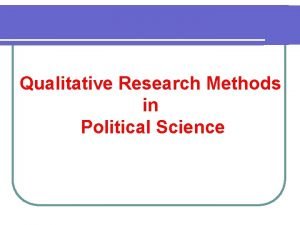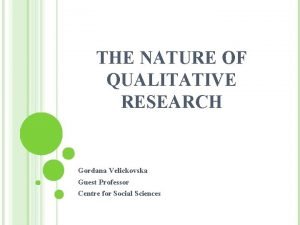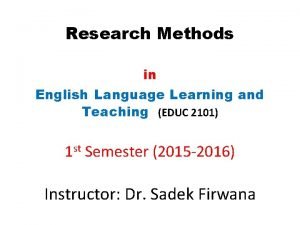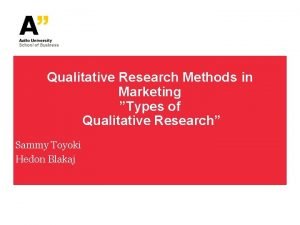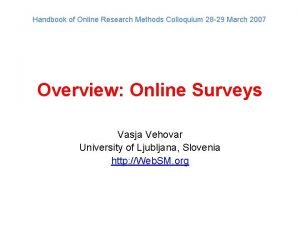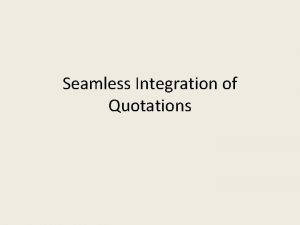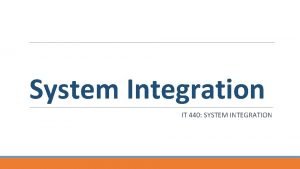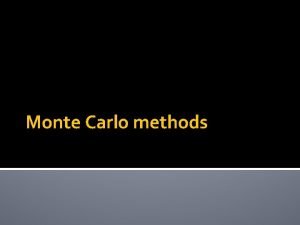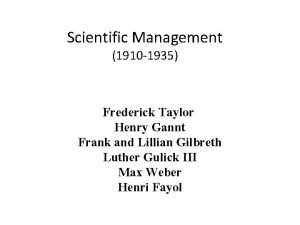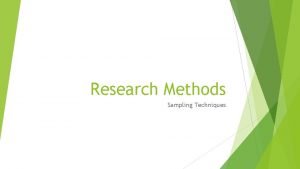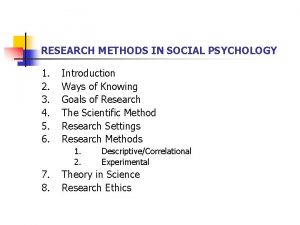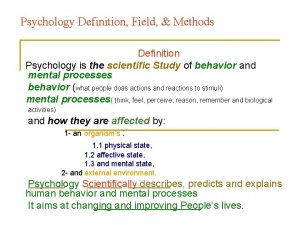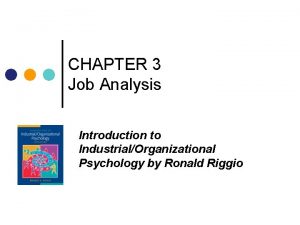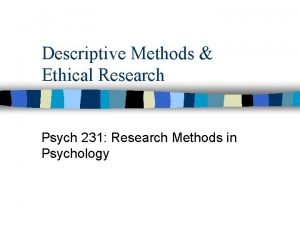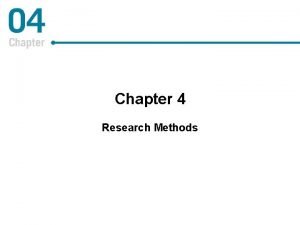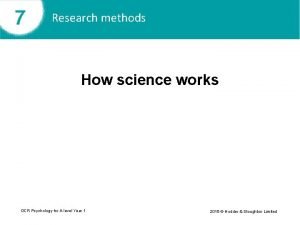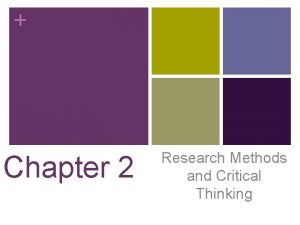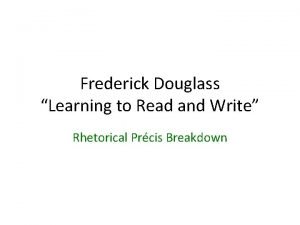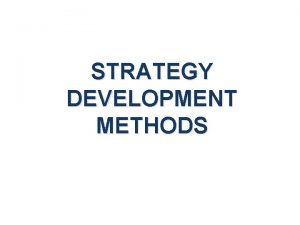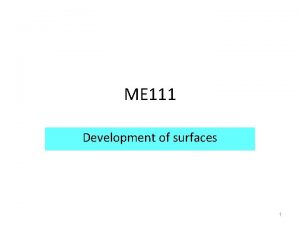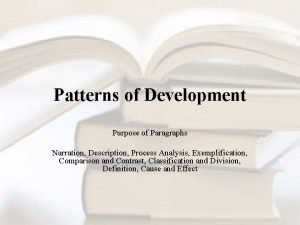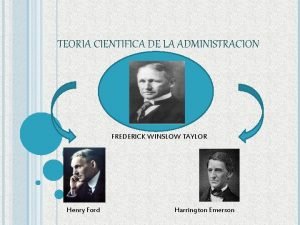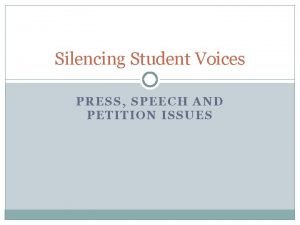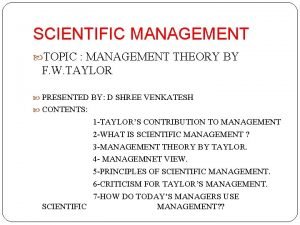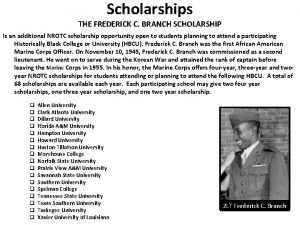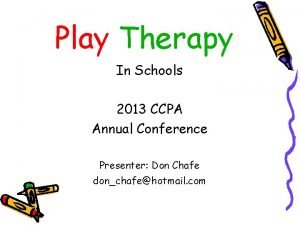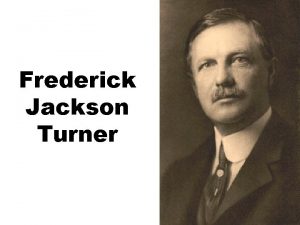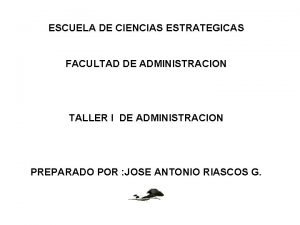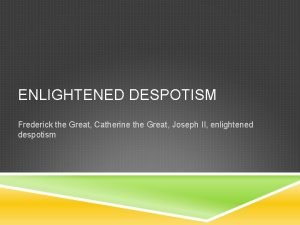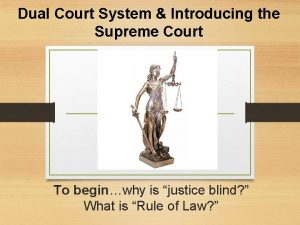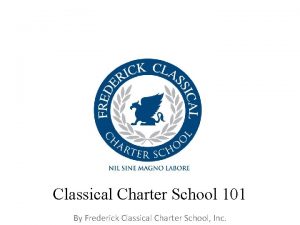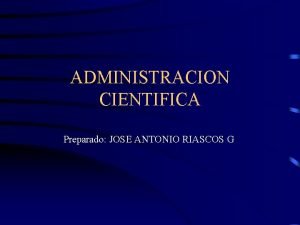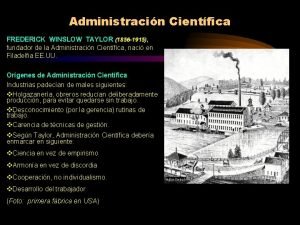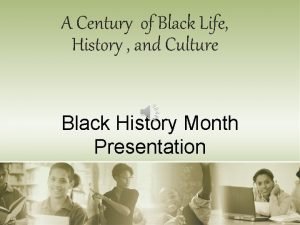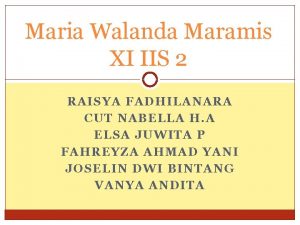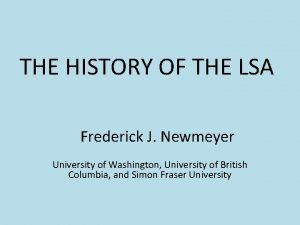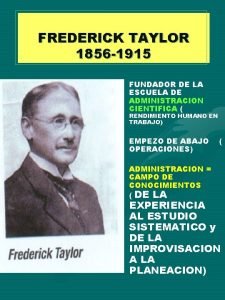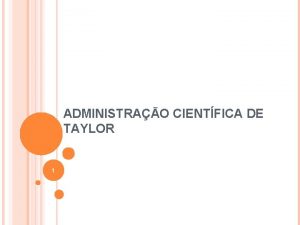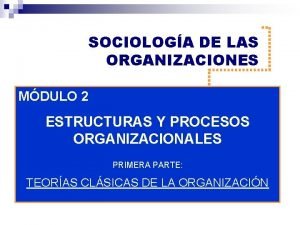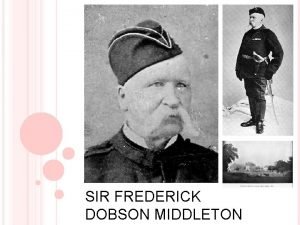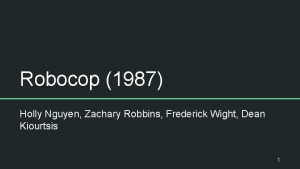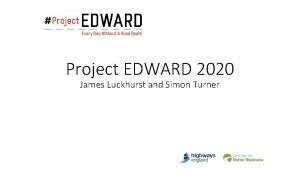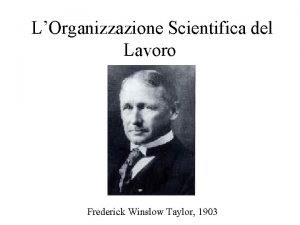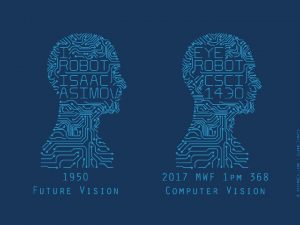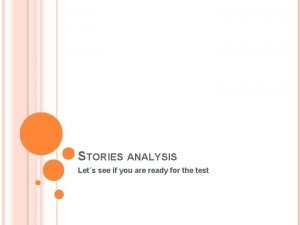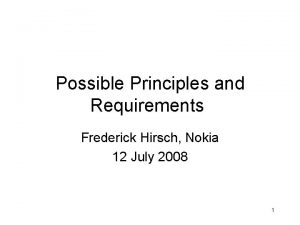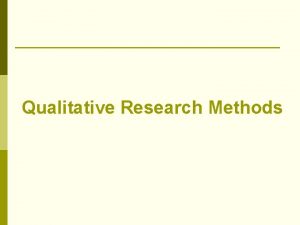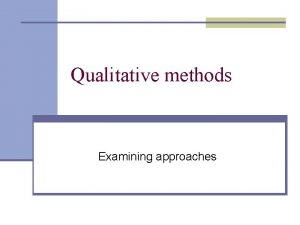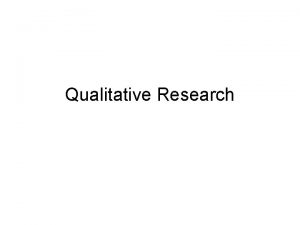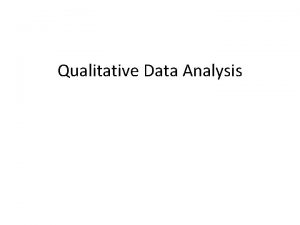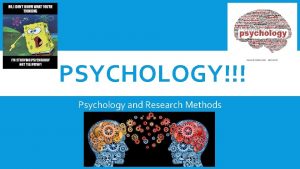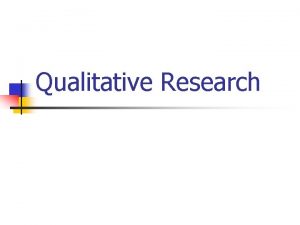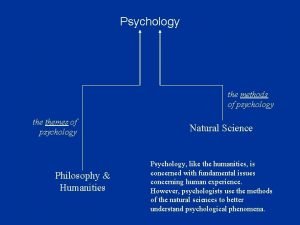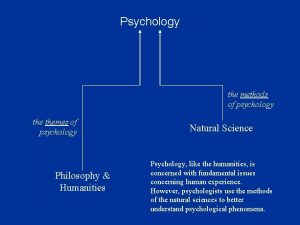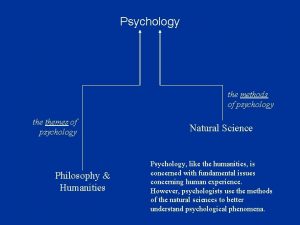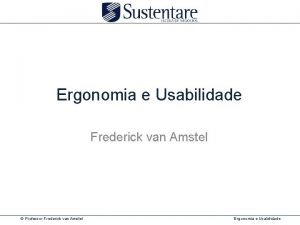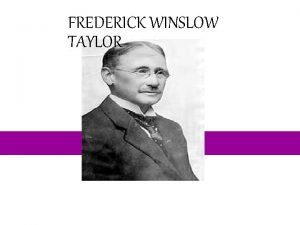Qualitative Methods in Psychology Development and Integration Frederick




















































































![Example Passage “[Division One should] bring people together. . . to discuss and write Example Passage “[Division One should] bring people together. . . to discuss and write](https://slidetodoc.com/presentation_image_h/86854b65ab1add934c492b43691fc718/image-85.jpg)


















- Slides: 103

Qualitative Methods in Psychology: Development and Integration Frederick J. Wertz Fordham University American Psychological Association Annual Convention 2019 Chicago, Illinois August 10, 2019

Outline A little background History and Importance of Qualitative Research Pioneers Flanagan “Revolution” Fundamental significance and utility Epistemic Value Social Value Phenomenology: An invaluable resource Phenomenological Psychological Reduction Eidetic Analysis Giorgi Comparative Methodology Duquesne Dissertations Victimization study Existential phenomenology Psychoanalysis 5 approaches to qualitative analysis Students’ work: The next generation Indigenous methods

45+ Years Undergraduate: Beloit College. Statistics teaching assistant, qualitative research on experience of time, phenomenology w/ Profs. Goldman & Summers Graduate: Duquesne University. Giorgi’s research and teaching assistant, philosophy, NIH study of crime victimization, qualitative analytic procedures, perception dissertation directed by Giorgi Faculty: Fordham University. Empirical investigations, common analytic procedures in existential and psychoanalytic psychology; history of qualitative methods; phenomenological reductions; comparative qualitative methodology; relations of quantitative and qualitative, and mixed methods; problem solving with students— clinical, developmental, & quantitative-psychometric; indigenous methods

Science: Epistemic and Social Values Science: Wedding of rationality and observation for responsible shaping of destiny Empiricism (original, broad sense) Conceptual precision (quantitative and qualitative reasoning) Telos: Ethical—Responsible practice in the social and natural world (Husserl) Rise & Development of natural science and technology Knowledge of material world Development of measurement and quantitative analysis Emphasis: quantitative reasoning, neglect of qualitative reasoning Critical Science Studies: Kuhn and beyond Contemporary methodological pluralism

“The sole aim of any society is to settle its problems in accordance with its highest ideals, and the only rational method of accomplishing this is to study those problems in light of the best scientific research. ” W. E. B. Du Bois, (1868 -1963) Du Bois, W. E. B. (1898). The study of Negro problems. Annals of the American Academy of Political and Social Science.

History and Development of Qualitative Methods in Psychology Philosophy Psychology • Positivism as universal science • • Late 19 th century philosophical recognition of need for alternative or supplemental methods Formal development of research methodology: Focus on measurement and quantitative analysis, reasoning • Practice of qualitative research without formal methodology (pre-1960). • Call for qualitative methodologies: 1940 s • Development of methodologies: 1960 s-90 s • Growth of applications, journals, education, conferences: Starting 1980 s • Qualitative Revolution: 1995 -present • Methodological pluralism • Phenomenological method • • • Psychology as fundamental empirical science • Specification of method • Phenomenological psychological reduction • Eidetic analysis Rise of continental philosophy Generative psychological research (by philosophers)

Philosophy of the Human Science Tradition Franz Brentano (1838 -1917) • Consciousness differs from physical things • Intentionality of consciousness • Psychology as a science of experience Wilhelm Dilthey (1833 -1911) • Naturwissenshaften differ from Geisteswissenshaften (Verstehen) • “We explain nature; we understand experience” • Knowing causality versus meaning

Practice in Psychology: Methods without Methodology Wilhelm Wundt Kurt Levin Sigmund Freud John Dollard William James Lawrence Kohlberg Jean Piaget Leon Festinger Frederic Bartlett Irving Janis John B. Watson Philip Zimbardo Edward B. Titchener Herbert Simon Abraham Maslow Daniel Kahneman

Wilhelm Wundt (1832 -1920) Völkerpsychologie (10 volumes, 1900 -1920)

William James (1842 -1910) Varieties of Religious Experience (1900)

Sigmund Freud (1856 -1939) Psychopathology, Dreams, Parapraxes, Jokes, Creative Works

Jean Piaget (1896 -1980) Cognitive Development, 1958

Gordon Allport called for “bold and radical experimentation” in Use of Personal Documents in Psychological Science, National Research Council “Strong counter-measures are indicated against theorists who damn the personal document with faint praise, saying that its sole merit lies in its capacity to yield hunches or to suggest hypotheses…they fail to express more than a small part of the value of personal documents for social science” (Allport, 1942, p. 191).

John C. Flanagan (1906 -1996) Critical Incident Technique

Career Timeline • 1941: Joined Army Air Forces as Major, promoted to Colonel • Director, Aviation Psychology Program, WWII: Selection of flight crews 150 psychologists and 1500 research assistants • Studies of effective military actions, e. g. , flight training and combat leadership • 1946: Critical Incident Technique (CIT) spelled out in military document • Professor, University of Pittsburgh: studies of effective teaching, dentistry, nursing, business, and government • Founded American Institutes for Research (AIR), 1946 • 1948: Edited The Aviation Psychology Program in the Army Air Forces: Report #1 (19 volumes) • 1951: President of Psychometric Society • 1954: Critical Incident Technique published in Psychological Review • President, 4 APA Divisions: Evaluation, Measurement & Statistics (5) 1956 • 5 psychologists working under Flanagan later became APA presidents, 11 served on APA Board of Directors

Critical Incident Technique (CIT) WWII Aviation Psychology Program, USAF Limits of questionnaires and expert opinions Virtues of concrete incidents of success and failure Importance of extreme examples Inductive analysis Applications in health care, education, psychology, business, APA ethics code

5 Steps of CIT 1. Determining aims 2. Making plans and setting specifications 3. Data collection 4. Data analysis - determining frame of reference - forming categories by inductive reasoning - determining level of generality for report 5. Interpretation and reporting

American Institutes for Research Objective: “… to contribute to the science of human behavior and the fuller development and utilization of mankind’s capacities and potential. ” 1950 s-1960 s--Provided data for selection of pilots, co-pilots, and flight engineers for commercial airlines for over 20 years 1959— For the National Board of Medical Examiners improved the validity of the licensing examination for Physicians by observing actual behavior in hospitals and collecting several thousand incidents of effective and ineffective medical performance, defining competence, and constructing new test. National board still uses this model for Part III 1960 s—In decolonized Africa, given lack of educated persons to meet independent nation’s needs, AIR implemented program in 19 developing countries identifying individuals with potential for vocational training and advanced degrees. 1960—Project TALENT surveyed 400, 000 high school students to assess educational needs. 1960 s—Project PLAN (Program for Learning in Accordance with Needs) constructed first individualized computer-assisted learning program for complete curriculum for grades 1 -12. AIR used CIT to develop a quality of life scale that is still used today

Quality of Life 16 Factors Based on CIT Physical and material well being Health and personal safety Relations with family Relations with close friends Relations with other gender Participation in social, community and civic activities Intellectual activities Aesthetic appreciation Spiritual development Developing skills and manual activities Understanding and appreciating oneself Occupational position Creativity Social recreation Spectator recreation Active recreation Cf. Maslow’s “need hierarchy”

Recent Innovations Redefinitions and extentions From ‘critical’ to ‘significant, ’ ‘revelatory, ’ ‘emotional, ’ ‘self • • interpreted’ From ‘incident’ to ‘experience, ’ ‘episode, ’ ‘transitional period’ Credibility checks and enhancements (ECIT): context inclusion, interview guides, independent analyses, category participation rates, participant verification, expert opinions, theoretical agreement, detailing procedures Broadening scope from predetermined outcomes to personal growth, challenging assumptions, value transformation Expanded data collection involving journals, portfolios, autobiographical narratives Use of phenomenological and narrative analytic methods

Bibliography Database Critical Incident Technique American Psychological Association Website Donated by Grace Fivars & Robert Fitzpatrick American Institutes for Research 50 Years of research: Articles, Reports, books, professional papers, dissertations Over 300 pages Over 3000 references Updates implemented by American Psychological Association

Development of APA Ethics Code 1947 Committee on Ethical Standards for Psychologists, chair Edward Tolman Choice of CIT as procedure APA members describe ethical actions, situations, and issues Second committee, chaired by Nicholas Hobbs, solicits 1000 ethical incidents Code based on incidents adopted in 1952 Critical incidents of ethical challenge and actions used in subsequent revisions of code through 1992 and 2002

Archives of the History of American Psychology Cummings Center for the History of Psychology University of Akron



Quality of Life Factors w/ illustrative quotations from CIT data

The Qualitative “Revolution” Sociology, anthropology, history, and humanities 1970 -1990 Psychology a late comer—mid 1990 s Philosophical (epistemological, ontological) and scientific rationales not the driving force Politically sensitive social and practical problems drive revolution Marginalized ethnicities in sociology 3 rd and 4 th world peoples in anthropology Feminism Practice areas: Counseling, education, nursing, social service Humanistic psychology: Human science methods based on phenomenology and existentialism (Giorgi), grounded theory (Rennie), and consensual qualitative research (Hill) but limited to counseling research

Spread of Qualitative Methods (1990 -present) Social Psychology (Marecek, Fine, and Kidder, 1997) Industrial-Organizational Psychology (Cassell and Symon, 2006) Counseling Psychology (Hoyt and Bhati, 2007) Educational Psychology (Chase and Villella, 2004) School Psychology (Michell, 2004) Clinical Child Psychology (Krahn, Holn, Kime, 1995) Health Psychology (Dickson-Swift, et al, 2007; Yardley, 2000) Cultural and Multicultural Psychology (Ratner, 2008; Ponterotto, 2002) Evaluation Psychology (Mark, 2002) Sport Psychology (Weinberg and Gould, 2009) Professional Psychology (Goldman, 1993) Health Care Systems (Hodges, Hernandez, Pinto, Uzzell, 2007)

Contemporary Methodological Pluralism Post-Positivist Existential Pragmatic Narrative Cultural/community based Mixed methods Interdisciplinarity and breakdown of boundaries Professional integrations Science, humanities, and arts Multi-media

Two Kinds of Scientific Reasoning Quantitative is Founded on Qualitative Quantitative reasoning/analysis—Magnitude: How much/many? Qualitative reasoning/analysis--Being: What? Quantification requires quality: No measurement without something measured What is measured? Quantity is itself a quality: Amount is a “what, ” a meaningful being “Clinical significance” Psychological significance

Construct Clarification: To what do our terms and measurements refer?

Intelligence

Edmund Husserl (1959 -1938) Mathematician, Philosopher Phenomenology: Universal Rigorous Science (including lived experience)

Husserl’s Legacy Publications introducing phenomenology as a method for philosophy and mental sciences 45, 000 pages of unpublished, untranslated manuscripts Analyses of body, time, intersubjectivity, passivity, alterity, ethics, practical life, genesis, generativity, history Not taught in Germany during Nazi era (1933 -1945) Few doctoral dissertations until the 1960 s Publications slowly emerging since the 1960 s Past criticisms unfounded: failed to take writings and discontinuous movements into account Unity of entire movement anticipated in Husserl’s work

Trans-Disciplinary Movement Archaeology, Architecture, Art History, Cognitive Science, Communicology, Counseling, Cultural Anthropology, Dance, Ecology, Economics, Education, English, Ethnic Studies, Ethnology, Ethnomethodology, Film Studies, French, Gender Studies, Geography, Hermeneutics, History, Linguistics, Law, Literature, Medical Anthropology, Medicine, Musicology, Neuroscience, Nursing, Religious Studies, Philosophy, Political Science, Psychiatry, Psychology, Psychopathology, Religious Education, Social Work, Sociology, Sport, and Theology (based on Embree, 2010)

Trans-National Movement Argentina, Australia, Austria, Belarus, Belgium, Brazil, Bulgaria, Canada, Chile, China, Colombia, Croatia, Czech Republic, Denmark, Finland, France, Germany, Greece, Hong Kong, Hungary, Iceland, India, Indonesia, Iran, Ireland, Israel, Italy, Japan, Korea, Latvia, Lebanon, Lithuania, Malta, Mexico, Netherlands. New Zeeland, Norway, Peru, Poland, Portugal, Romania, Russia, Serbia, Slovenia, South Africa, Spain, Switzerland, Taiwan, Tunisia, Turkey, United Kingdom, United States of America, and Venezuela. (Embree, 2010)

Phenomenological Method Basics Concrete example(s) of subject matter under investigation Phenomenological psychological focus (“reduction” (to pure animate experience) Setting aside theory, previous research, preconceptions Setting aside the objective and material world apart from experience Focusing on intentional processes and objects (psychological) Eidetic analysis (of invariance, “essence”--the ”what”) Multiple examples from others and self Free imaginative variation Universal law Natural language description of structure(s): Ideographic and nomothetic levels of generality

Phenomenological Movement Contemporary Psychology Philosophical clarifications for human science Theoretical grounding, critique, and unification Research methodology 1) Phenomenological method development (e. g. , Giorgi, 2009) 2) Critique of diverse methods (e. g. , neo-positivist, grounded theory, discourse analysis, narrative) 3) Mixed method synthesis Positive research programs 1) Original studies 2) Meta-analytic studies Trans-disciplinary Collaboration and Interdisciplinary inquiry

Amedeo Giorgi Methods for Human Science Research

Amedeo Giorgi (1967): Experimentation with Qualitative Analysis

Giorgi’s Specification of Analytic Procedures • Attitude: - Suspend prior knowledge of topic - Suspend concerns about reality independent of experience - Phenomenological reduction (focus on experience, intentionality) - Eidetic Reduction (focus on essence, eidetic analysis) • Protocol Analysis--Procedures: 1. Open Reading 2. Demarcation of meaning units 3. Psychological Reflection on each meaning unit 4. Synthesis: Description of structure(s): Ideographic and nomothetic

Comparative Methodology Common Analytic Procedures Duquesne University doctoral dissertations (~100) Criminal Victimization study (Reflection in depth and detail) Existential phenomenological psychology literature Psychoanalysis History of qualitative research (before formal methods) Contemporary pluralism

Comparison of 5 Analytic Methods Phenomenology (me) Grounded Theory (Kathy Charmaz) Discourse Analysis (Linda Mc. Mullen) Narrative Research (Ruthellen Josselson) Intuitive Inquiry (Rosemarie Anderson)

Common Fundaments of Qualitative Research Reflexive account of presuppositions Concrete examples—observations, descriptions Critical assessment of data: context, limits, and appropriateness Transparent account of procedures Open, multiple readings Language sensitivity to expression in context Emergent ideation rooted textual data Meaning explication—differentiation, articulation Holistic account of structural organization Analytic comparison of multiple examples Evidence presented in support of knowledge claims Emphasis on subjectivity: embodied, practical, affective, linguistic, social, cultural, and temporal Self-critical reflexivity on limits of research

Distinctive Features of Qualitative Traditions Phenomenological Psychology Epochés (abstention from natural science, theory, and existential positing) Intentional analysis of structures of lifeworld Imaginative variation in eidetic analysis to clarify qualitative generalities Grounded Theory Mid-level theory building and testing (abductive reasoning) Theoretical sampling of data Bridging with traditional hypothetical science Discourse Analysis Reinterprets traditional concepts as discursive practices Radical focus on language, including social contexts and consequences Special tools of and procedures for linguistic analysis Narrative Research Engages diverse disciplinary, theoretical, and social positions Organizing and meaning-making functions of story telling Use of literary conventions of analysis Participatory Action Research Practical, emancipatory aim Partnership with participants in all phases of research Critical theory

Qualitative Clarification of Quantitatively Based Knowledge Comparative Research on Clinical and Sub-Clinical Bulimia (BN) Niki Skoufalos Clinical Psychology Fordham University

Problems and Research Question The diagnostic criteria for bulimia nervosa has changed continually over history Research shows that similar factors are correlated with binging and purging at clinical (diagnosable) and sub-clinical (insufficient to meet current diagnostic criteria) levels. Debate over arbitrariness of diagnostic criteria. Concern that sub-clinical bulimic population is at risk for developing clinical bulimia and needs psychological services What is the psychology of these two populations: are they qualitatively similar or different?

Methods Recruitment & Selection From 322 undergraduates, 4 clinical BN and 10 SCBN, 6 non. BN Instruments Demographics Form Revised Restraint Scale (RS; Polivy & Herman, 1985) EDI-3 (Garner, 2006) Personal Style Inventory-II (PSI-II; Robins et al. , 1994) Dissociative Experiences Scale-II (DES-II; Bernstein & Putnam, 1986) State-Trait Anger Expression Scale-2 (STAXI-2; Spielberger, 1999) Good Experiences Questionnaire (GEQ) SCID-I/NP (First et. al. , 2002) Interview/Focus Group Guide Data Analysis Psychological phenomenological analysis (Giorgi, 1985) 6 Individual analyses and structures, 4 Modified Analyses Comparative analyses of 20 individuals and 3 focus groups --3 General structures Search for confirmation and disconfirmation in all data

General Psychological Structure 1: Clinical BN Voracious adult appetite and love of food Loneliness and isolation in face of consistent abandonment, neglect, and rejection Persistently failing attempts to solicit care, help, affection, and belonging Detachment and angry blaming of self and others Adolescence: Pervasive emptiness and risk of fading into social obscurity Body dissatisfaction as part of overall sense of unworthiness Influence of the media/Ideal of thinness Observational learning of the binge and purge Binging as self care and purging in hope of attracting others Secret effective comfort and desirability through binging and purging: Hope for emotional change

General Psychological Structure 2: Sub-Clinical BN Intermittent experiences of abuse, neglect, rejection Learning to suppress anger at risk of loss or counter-attack Forming a protective, gratifying alliance with family member against abusive/rejecting parent and others Appropriating the standards/values/ideals of the ally for safety Satisfaction, acceptance and belonging through efforts at perfection Dieting fails at minimizing risk of rejection as body grows in adolescence Binging as means to numb emotional disturbance and gain pleasure when facing interpersonal discord and rejection Purging to prevent rejection and to achieve belonging through perfect (thin) body Unexpressed desire to share emotional disturbance and anger with an accepting other

Clinical and Subclinical BN: Continuity & Discontinuity Continuity Spontaneous Enjoyment of Food Observation of Others Engaging in Binge-Purge Behaviors Use of Binge to Provide Soothing Comfort Desire to be Accepted Difficulty Expressing Emotions Perceived as Unwelcome Discontinuity Qualitative differences in meanings of eating patterns and structure of the life-development The same etiological and associated factors hold various meanings that sharply contrast among the three participant groups

Qualitatively Based Measurement: Catholic Institutional Identity In Higher Education Ann Higgins Kathy Jankowski Applied Developmental Psychology

Top Down-Bottom Up Method Review of literature: education and theology Interviews with administrators, faculty, students, and staff Conceptual analysis Phenomenological analysis Identification of 6 essential constituents Construction of preliminary instrument 300 Questions drawn from interviews Reduction to 100 non-redundant questions

Institutional Culture: Six Constituents Visible links to the Catholic Church Charism Curriculum Behavioral norms Personal formation Multireligious culture

Multi-Religious Culture Non-religious perspectives are respected on campus. Students gain familiarity with their own religious tradition here. Catholic students feel more at home here than non-Catholic students. The availability of religious symbols and services from multiple faiths deepens student thinking. Students engage in exercises or practices of their own faith on this campus. Students of all religious backgrounds are welcome here. Campus ministries are active. There are only Catholic religious symbols on campus. There is not much religious diversity on this campus. Places of worship for various religious groups are available on campus.

Fordham University Climate Survey Instructions Ø The following statements may describe aspects of university climate and life on campus. Ø For each statement, first, check the box that you think best applies to your university currently (Does Not Describe at All, Does Not Describe Well, Describes Partly, Describes Mostly, Describes Completely, or Don’t Know). Ø Second, rate how important this aspect is for you on a scale of 1 -5, 1=Not Important and 5=Very Important. There are no right or wrong answers.

Fordham University Climate Survey Sample Questions Education at this university aims to develop leaders who strive to right social injustices. Critical thinking is encouraged across the curriculum. Catholic Mass is easily accessible on campus. Students of all religious backgrounds are welcome here. This university enhances a student’s ability to make difficult personal moral decisions.

Qualitative Understanding of Quantitative Anomalies Effectiveness of Reading & Math Programs For Children Ages 3 -8 in Inner City Schools Kimber Bogard Applied Developmental Psychology Fordham University

Measures: 3 Urban Schools Outcomes: Reading Test Scores Math Test Scores Structural and Process variables: Class size Classroom student-adult ratios Emotional climate of classroom Teacher years of education Teacher special training Teacher sensitivity

Predictions Not Supported Mostly non-significant relationships between educational variables and reading/math outcomes across schools School as moderator of relationship between structure and process variables In School L, teachers’ years of experience and specialized training correlated with instructional climate and student performance whereas in Schools M and Q, no relationship between teacher education and instructional climate or student performance Schools M and Q were higher than School L on emotional and instructional climates Number of adults in classroom and class size positively correlated with performance (against prediction)

Teaching in Silos (School L) Monthly meetings to discuss curriculum and standards Teachers drew on education for methods of implementation Teachers reflected in isolation on how to solve problemsmeet standards No interaction with teachers in same or other grades about common or unique activities Variability in assignments, assessments, and supplementary curricular materials

Unidirectionally Coached Teaching (School Q) Literary Coach selected by principal Met with teachers at each grade Described standards/goals Provided tools of assessment Provided tools for implementation developed by others • Standard received procedures at each gade level Stable over time No input from teachers

Dynamic Collective Improvisation (School M) Principal is both a visionary leader with no set plan and practically provides the time and space for open discussion Team-oriented meetings designed to air problems, find collective solutions to challenges Working synergy among stakeholders Ownership of the teaching curriculum and assessment New insights lead to adjustment in methods

Anomalous Findings

Conclusions No general quantitative relationships between isolated educational variables and student outcomes as predicted Qualitatively determined holistic school organizations moderated and were related to both educational variables and student outcomes School (M) with principal’s vision and leadership, teacher ownership of programs, collaborative teacher alliances within and between grade levels, and creative problem solving among diverse stakeholders had best educational environment and highest achievement outcomes despite largest class sizes and low teacher-student ratios. School (Q) with special, shared coaching, materials, and tools had middle level performance and teacher education and years of experience, like school M, were unrelated to structural and outcome variables School (L) with teachers isolated and left to their own devices to deal with challenges achieved lowest scores and outcomes varied with teachers’ educational level, specialized training, and years of experience

Mathematical Modeling Integrating Qualitative Methods: Graduate Student Adjustment Arnond Sakworawich Psychometrics Fordham University

Objectives To formulate a method for constructing a mathematical model from qualitative data. To demonstrate the method with a person-centered mathematical model of student’s adjustment to graduate school. 67

Approaches to Mathematical Modeling Empirical approach to quantitative data Galileo –pulse and an pivoting pendulum in Pisa tower. Pendulum law Psychophysics – Steven, S. S. (power law) Curve fitting Exploratory Data Analysis (John Tukey) Finding patterns (of relationship) in data Logical – mathematical derivation Isaac Newton - Used calculus to develop a theory of modern mechanics and gravitational force Classical test theory (Charles Spearman and others) Item response theory (Lord & Novick) Generalizability theory (Cronbach & Gleser)

Nobel Prize Winning Psychologists Mathematical Models from Qualitative Data Herbert A. Simon Think aloud protocols Protocol Analysis Artificial intelligence and expert systems theory Daniel Kahneman (& Amos Tversky, deceased) Play gambling, Jerusalem afternoons Described thinking, sought consensus Derived prospect theory with mathematics

Data collection 14 graduate students wrote narrative descriptions of their adjustment to graduate school Examples the critical incidents of good versus bad adjustment Students conducted in-depth follow up interviews on each narrative

Analysis Step 1: Open Reading Read all descriptions and interview transcripts to get a sense of a whole data. Bracketing myself Follow, empathize, and understand lived through experiences

Analysis Step 2. Intentional analysis Demarcate meaning units Identify relevancy to adjustment to graduate school Psychological reflection on each relevant meaning unit Reflect on interrelation of personal meanings

Analysis Step 3: Open coding Name conceptual categories (variables) Break down into units of meanings and concepts Underline important quotations, comments and take notes Quotation: “She (mentor) was very erratic. Her mood was never predictable. Every day, I would come to work and ask her administrative assistant what kind of mood she was in. ” Categories: unpredictability, ambiguity, frustration-with mentor

Analysis Step 4: Grouping Concepts and Meanings Aim Simpler but powerful variables (to be parsimonious) Procedures Sort several concepts into piles by similarities Organize piles into hierarchy of structures Graphic representation using map Verify results with method of constant comparison

Hierarchical Structure: Discrepancy as Motivation to Adjustment Level I Discrepancy Past status quo vs. current state Weather Language Finance Self expectation vs. actual performance Classroom Level II Other vs. self Other’s expectation vs. own performance Level III Mentor Workload Classmate Time management Research Family - Lovers

Axial Coding Explore the interrelationship between variables. Find evidences for interrelationships among variables – sign and direction- Iterative process Support (-) Suffering + Frustration --- Support mitigates suffering. At the very least, they understood the difficulties I was enduring and we could commiserate about working for this particular professor and the hardships of graduate school together. Diagramming Path Diagram – Easy to be converted into systems of equations

Graphic Diagram for Adjustment to Graduate School status quo vs. current state Self Importance* expectation vs. Negative actual Discrepancy performance other vs. self actual Interpretation performance other’s expectation Sense of vs. own efficacy performance Sense of Support meaningfulness Mental Toughness Happiness. Unhappiness - Ambiguity and unpredictability

Theory Construction Through Selective Coding and Eidetic Analysis Conversion of diagram into equation Create explanatory whole using free imaginative variation One comprehensive structure that synchronizes all constituents of the model Starting with concrete examples and then imaginatively varies it in every possible way to extract the essence or theory that can exhaustively reflect the whole phenomenon Requires creativity Verification with data Use theory to make predictions and then validate with data Requires analytical and critical thinking. Loop until theoretical saturation

Mathematical Model of Adjustment to Graduate School - subscript i = ith aspects of graduate student life - = Happiness—Unhappiness IPi is the Inter. Pretation which composed of, a) sense of efficacy, b) sense of meaningfulness, c) perceived support, and d) mental toughness NDi is the Negative Discrepancy (Present is worse than the past or expectation) between a) Past status quo vs. current state, b) expectation vs. actual performance, c) other vs. self, and d) other’s expectation vs. own performance. Vi is Value – importance or priority given to each aspect for negative discrepancy Ai is Ambiguity and unpredictability

How Does a Person Adjust? Holistic approach to adjustment to graduate school (LHS) Cope with Happiness-Unhappiness directly Convert unhappiness into goal, challenge, or humor Compensation Freely transform those variables in the equation (RHS) Change Value (V) Close Negative Discrepancy (ND) Learning and hardworking Lower own expectation Stop comparing Compare to the right person Make other to expect themselves to be closer to reality Do nothing Change Interpretation (IP) to be positive Be tougher Positive self talk – boost up sense of efficacy Seek support from significant others—mentor, teachers peers Cognitive reframing on meaning – search for meaning Decrease ambiguity and unpredictability 80

Person-Centered Applications • Program Design Graduate Student Orientation Faculty-Student Interactive Meetings/ Workshops • Program Evaluation Measurement Assessment • Counseling Individual Group • Interventions Development 81

Mixed Methods Research on Psychology Discourse and Meanings of Unity in Psychology Charles Olbert Clinical Psychology Fordham University w/ L. Osbeck, President, APA Division of General Psychology (1)

Data Collection 27 newsletter issues Spring 1999 to Fall 2012 24 w/data (88/9%) Explicit statements about general psychology 67 total articles/candidate statements

Data Coding Passages read twice 1: assigned preliminary code words 2: recoded and transcribed Multiple codes/passage 128 passages 81 preliminary codes Cleaned database Consolidation & correction 42 final codes
![Example Passage Division One should bring people together to discuss and write Example Passage “[Division One should] bring people together. . . to discuss and write](https://slidetodoc.com/presentation_image_h/86854b65ab1add934c492b43691fc718/image-85.jpg)
Example Passage “[Division One should] bring people together. . . to discuss and write integrative, actionoriented papers, particularly with a view toward making Psychology work for the public good. ” DIALOGUE INTEGRATION PUBLIC GOOD

Thematic Analysis A. DIALOGUE B. INTEGRATION C. DIVERSITY APPRECIATION D. THEORY E. HUMANITARIANISM F. EMPIRICISM

Comparative Theme Analysis General Psychology vs. Unity Same or different conceptualization within Division One? Compared theme frequencies in passages with ‘Unity’ code versus those without χ2(5, 243) = 6. 56, p =. 255 Essentially similar thematization

Theme Frequencies % of passages involving each theme 35. 0% 30. 0% 25. 0% 20. 0% 15. 0% Div One APA PC 10. 0% 5. 0% pi ric is m ria an ita um Em ni sm ry H Ap er si ty iv D Th eo ec. pr io n gr at te In D ia l og u e 0. 0%

Comparative Theme Analysis Division 1 vs. APA Candidates Are discourses the same or different? Compared frequencies of themes χ2(5, 317) = 29. 8, p <. 0001 Significantly different discourses

Thematic Links Division One APA Candidates

Themes: Constitutive Links Theory Integration Dialogue Diversity Appreciation Humanitarianism Empiricism: Unity as Homogeneity ?

Themes: Constitutive Links Theory Informs Founds Integration Informs Founds Dialogue Informs Founds Diversity Appreciation Informs Founds Humanitarianism?

Science & Human Values Pervade Science A. Dialogue: Social B. Integration: Epistemic C. Diversity Appreciation: Social D. Theory: Epistemic E. Humanitarianism: Social F. Dialogue: Epistemic

Summary and Conclusions Mixed methods research is on the rise and becoming a new scientific standard in psychology Quantitative and qualitative goals and questions are different, involve distinct perspectives and methods Quantitative knowledge is dependent on qualitative, not vice versa Quantitative methods have been extensively developed and dominated psychology’s view of science Historically qualitative methods have been used informally, but formal methods and methodologies are becoming available Qualitative goals, questions and methods can now be formally integrated with quantitative research: Infinite possibilities

Indigenous Psychological Methods Non-Western Rationalities, observations, practices 95

Linda Tuhiwai Smith Decolonizing Methodologies: Research & Indigenous Peoples “The word itself, ‘research, ’ is probably one of the dirtiest words in the indigenous world’s vocabulary. ” (Smith, L. T. (2012). Decolonizing Methodologies: Research and Indigenous Peoples, second edition. London: Zed Books. )

Virgilio Enriquez (1942 -1994) Sikolohiyang Pilipino (Filipino psychology)

Rogalia Pe-Pua

Sikolohiyang Pilipino (Filipino psychology) Virgilio Enriquez: Kapwa (shared identity, self-other unity) Pakapa--A suppositionless approach in social scientific investigations: search for meaning (Santiago, 1977; Torres, 1982) Abstention from prior theories and received methods Original methods developed: Pakikipamuhay (living with) (Enriquez, 1994, p. 58) Methodological norms: participant input, equal status/power, primacy of participant well-being, all procedures within cultural norms (including language), integration of multiple indigenous methods (Pe-Pua, 2006) Universal potential: Used by Hawaiians, Koreans, Japanese, Australian migrant and ethnic communities, Chinese, Macedonians, Pacific Islanders, Koreans, Serbians, Croatians, Lebanese, South Americans, Portuguese (Pe-Pua, 2006, 122).

Export (Potential Universality) “(T)he indigenous Filipino philosophy of science is more exacting than its Anglo-American counterpart … [and this] incorporates the demands of empirical validation from katatagan (‘replicability and reliability’), to katapatan (‘multiple operationism and validity’) but also requires patibay (‘certification’), patotoo (‘affirmability and attestability’) and patunay (‘authenticity’)” (Enriquez, 1994, p. 49).

Analysis of Sikolohiyang Pilipino 1977 -2008 Clemente (2011) 276 articles in Philippine Journal of Psychology 2 Categories of articles on Filipinos Non-Filipino Psychology (FP): 39% (85) Quantitative methods: 73% (62) Literature review & theoretical: 12% (10) Qualitative methods: 3. 5% (3) Mixed methods: 11. 8% (10) Filipino Psychology: Quantitative: 42. 5% (57) Qualitative: 27. 6% (37) Mixed methods: 12. 7% (17) Indigenized from without: 53% (71) Indigenized from within: 47% (63)

Clemente’s (2008) Results Continued • Non-FP studies spanned all topical areas of Western psychology I/O remained entirely in Western frameworks 70. 1% (94) used non-elite populations, only 9% (12) used only university students Large majority addressed social/national issues 2/3 of FP used indigenized theory Only 12. 7% (17)practiced methodological indigenization (87. 3% [117] non-indigenous methods.

Thank You!
 Random sampling method in quantitative research
Random sampling method in quantitative research Integrating qualitative and quantitative methods
Integrating qualitative and quantitative methods Forward integration and backward integration
Forward integration and backward integration Vertical diversification example
Vertical diversification example Example of simultaneous integration
Example of simultaneous integration Effective methods for software and systems integration
Effective methods for software and systems integration Sampling of qualitative research
Sampling of qualitative research Political science methodology
Political science methodology Qualitative vs quantitative research
Qualitative vs quantitative research What is qualitative research and its characteristics
What is qualitative research and its characteristics Visual methods in qualitative research
Visual methods in qualitative research Qualitative research methods
Qualitative research methods Qualitative research methods
Qualitative research methods Axiology of constructivism
Axiology of constructivism Qualitative research methods
Qualitative research methods Qualitative forecasting methods
Qualitative forecasting methods Quote integration methods
Quote integration methods Seamless quote example
Seamless quote example System integration methods
System integration methods Integration methods
Integration methods Wax pattern fabrication pdf
Wax pattern fabrication pdf Frederick taylor and frank and lillian gilbreth
Frederick taylor and frank and lillian gilbreth Joint capabilities integration and development system
Joint capabilities integration and development system The joint capabilities integration and development system
The joint capabilities integration and development system Jcids process chart
Jcids process chart Sampling techniques psychology
Sampling techniques psychology Research methods in social psychology
Research methods in social psychology Research methods in developmental psychology
Research methods in developmental psychology Field methods in psychology
Field methods in psychology Job analysis vs job evaluation
Job analysis vs job evaluation Descriptive methods psychology
Descriptive methods psychology Research methods in abnormal psychology
Research methods in abnormal psychology Ocr psychology research methods
Ocr psychology research methods Chapter 2 critical thinking answers
Chapter 2 critical thinking answers Introspection method of psychology
Introspection method of psychology Rhetorical devices in learning to read and write
Rhetorical devices in learning to read and write Harriet jacobs and frederick douglass
Harriet jacobs and frederick douglass Frederick twort
Frederick twort Observation in system analysis and design
Observation in system analysis and design Agile embedded software development
Agile embedded software development Strategy development methods
Strategy development methods Development of surfaces
Development of surfaces Accenture delivery suite
Accenture delivery suite Pattern in development
Pattern in development Patterns of paragraph development examples
Patterns of paragraph development examples Positive psychology ap psychology definition
Positive psychology ap psychology definition Groupthink vs group polarization
Groupthink vs group polarization Social psychology ap psychology
Social psychology ap psychology Social psychology definition psychology
Social psychology definition psychology Health psychology definition ap psychology
Health psychology definition ap psychology Milton henschel
Milton henschel Frederick taylor teoria
Frederick taylor teoria William frederick harris
William frederick harris Importance of being earnest characters
Importance of being earnest characters Tim fredrick
Tim fredrick Elton mayo teoria
Elton mayo teoria Frederick taylor teoría científica de la administración
Frederick taylor teoría científica de la administración Hosty v carter
Hosty v carter F.w taylor contribution to management
F.w taylor contribution to management Frederick c branch scholarship schools
Frederick c branch scholarship schools Is saving private ryan based off a true story
Is saving private ryan based off a true story Frederick perls
Frederick perls Frederick banting facts
Frederick banting facts Frederick wilfrid lancaster
Frederick wilfrid lancaster Father scientific management
Father scientific management Frederick jackson taylor
Frederick jackson taylor Frederick douglass brainpop
Frederick douglass brainpop Guiles v. marineau
Guiles v. marineau Gestalt therapy goals
Gestalt therapy goals Escuelas cientificas de la administracion
Escuelas cientificas de la administracion Enlightened despot catherine
Enlightened despot catherine Morse v frederick summary
Morse v frederick summary What is education
What is education Frederick perls
Frederick perls What did frederick m jones invent
What did frederick m jones invent Administracion cientifica introduccion
Administracion cientifica introduccion ¿cuáles son los 4 principios de frederick taylor?
¿cuáles son los 4 principios de frederick taylor? John w reed rolling pin
John w reed rolling pin Lancaster autor
Lancaster autor Frederick douglass quotes
Frederick douglass quotes Frederick douglass talbot county
Frederick douglass talbot county Joseph frederick caselung walanda
Joseph frederick caselung walanda Frederick douglass reading comprehension
Frederick douglass reading comprehension Griffith 1928
Griffith 1928 Frederick newmeyer
Frederick newmeyer Maysam mousaviraad
Maysam mousaviraad Frederick taylor (1856-1915)
Frederick taylor (1856-1915) X cel primary care frederick
X cel primary care frederick Frederick douglas high school
Frederick douglas high school Frederick m lehman
Frederick m lehman Types of lad artery
Types of lad artery Langerhans
Langerhans Emperor frederick
Emperor frederick Seguidores de taylor
Seguidores de taylor Frederick william danker
Frederick william danker Taylorismo
Taylorismo Frederick dobson middleton
Frederick dobson middleton Frederick wight
Frederick wight Simon turner frederick md
Simon turner frederick md Frederick winslow taylor teoria
Frederick winslow taylor teoria Frederick kingdom
Frederick kingdom Frederick dobson middleton
Frederick dobson middleton Televebin
Televebin Frederick hirsch
Frederick hirsch







